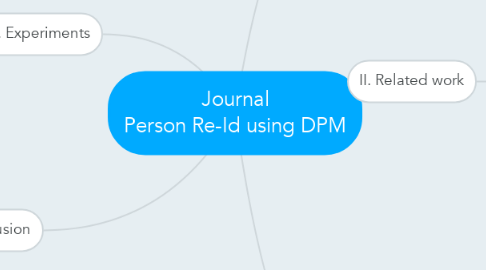
1. IV. Experiments
1.1. 4.1. Datasets and Evaluation
1.1.1. Dataset
1.1.1.1. ETHZ
1.1.2. Evaluation
1.1.2.1. CMC
1.2. 4.2. Experiment setup
1.2.1. exp setup
1.2.1.1. How to form Gallery and Probe set
1.2.1.2. Number of DPM parts: 4, 6, 8
1.2.1.3. Fusion: 4&6, 4&8, 6&8
1.2.2. DPM Training
1.2.2.1. Training set
1.2.2.1.1. INRIA Person
1.2.2.1.2. ETHZ
1.3. 4.3. Results and discussion
1.3.1. Show result figures
1.3.2. Result
1.3.2.1. Outperformance over SDALF
1.3.2.2. Fusion boosts the performance
1.3.3. Discussion
2. V. Conclusion
2.1. The proposed method outperforms SoA methods
2.2. Could be applied to other re-id problems
3. I. Introduction
3.1. Intro to Person Re-Id
3.1.1. Definition
3.1.2. Applications
3.1.3. Challenges
3.2. Proposed method
3.2.1. Motivation
3.2.1.1. Existing works --> Part localization: fixed part structures
3.2.1.2. Examples
3.2.1.2.1. SDALF
3.2.2. Propose Machine-learning based Part localization
3.2.2.1. DPM
3.2.3. Advantages of proposed method
3.2.3.1. Flexible part structure
3.2.4. Experiments
3.2.4.1. Dataset: ETHZ
3.2.4.2. Result: Showing the outperformance
4. II. Related work
4.1. Features
4.1.1. Feature type
4.1.1.1. Low-level
4.1.1.2. Semantic
4.1.2. Human part matching
4.1.2.1. Part localization
4.1.2.2. Interest point matching
4.2. Distances
4.2.1. Learning transformation
4.2.2. Learning metric
5. III. Proposed method
5.1. 3.1. Part localization
5.1.1. Overview+Analysis of part localization in existing methods
5.1.2. Motivation
5.1.2.1. Existing work: fixed part structure
5.1.3. --> Need a flexible method for part localization
5.1.4. --> Machine learning-based: DPM
5.1.4.1. Description about DPM
5.1.5. How to apply DPM to Person Re-Id
5.1.6. Figure
5.1.6.1. a DPM Model
5.1.6.2. DPM applied to person detection
5.2. 3.2. Feature extraction
5.2.1. Overview of features in existing methods
5.2.2. Characteristics of person re-id images --> criteria for features
5.2.3. Chosen features
5.2.3.1. HSV Histogram
5.2.3.2. MSCR
5.2.3.2.1. Description about MSCR
5.2.4. Figure
5.3. 3.3. Computing distances
5.3.1. Compute Final distance from partial distances (distances between features)
5.4. 3.4. Fusion
5.4.1. Motivation for fusion
5.4.2. Fusion method
5.4.2.1. Linear combination of single scores
5.4.3. Figure

